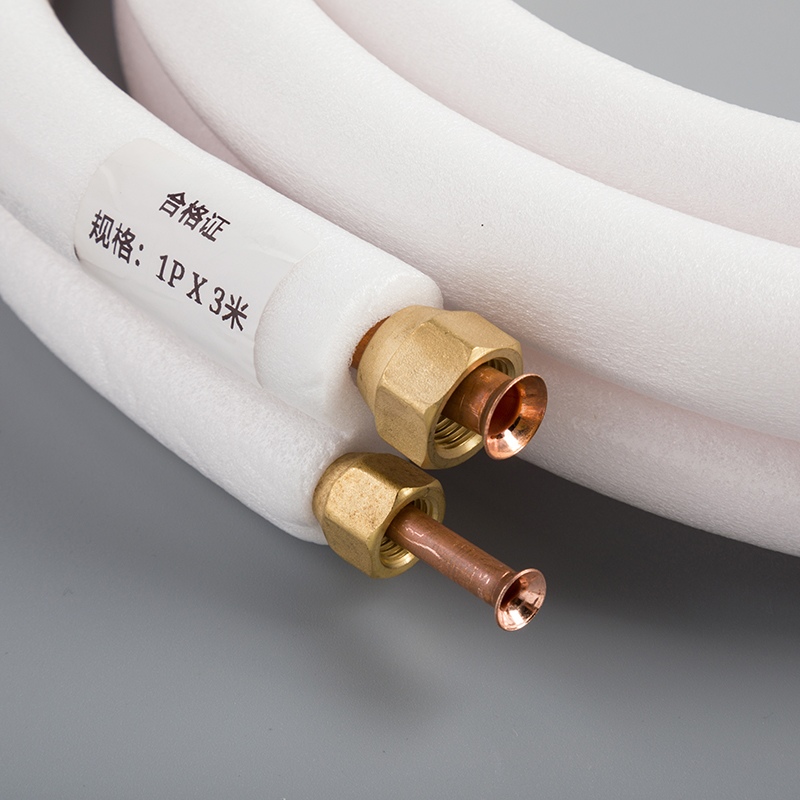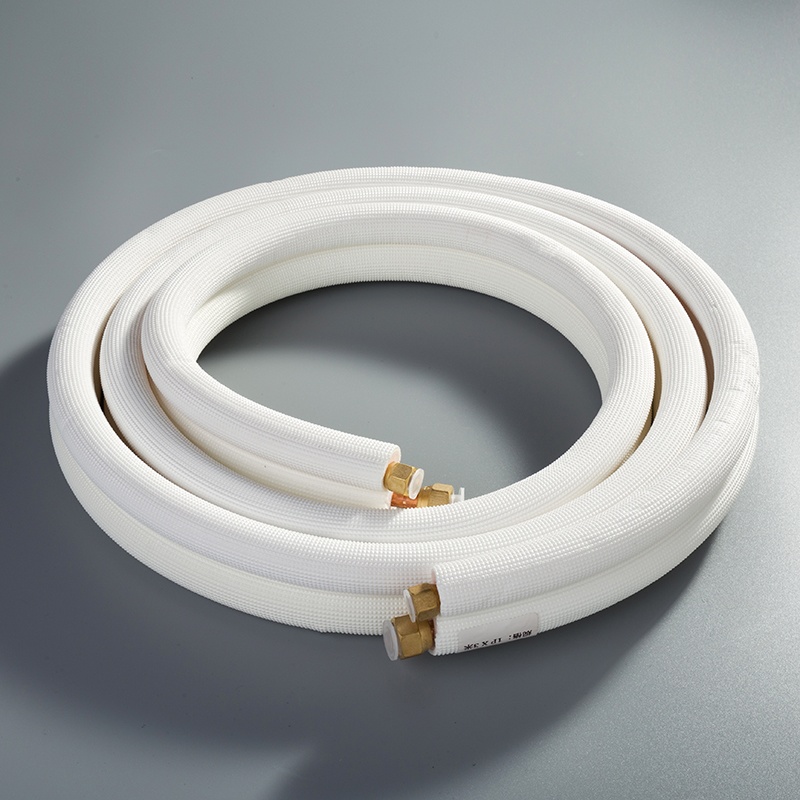How to Repair a Leaking Copper Pipe in Your Air Conditioner

A leaking copper pipe in your air conditioner can lead to several problems. You might notice higher energy bills, water damage, or even mold growth. The system may lose refrigerant, causing it to stop working. Here’s a quick look at the common consequences:
Consequence | Description |
|---|---|
Loss of refrigerant | The refrigerant escapes, making the air conditioner ineffective. |
Water damage | Leaks can damage nearby walls, floors, or ceilings. |
Increased energy bills | The system works harder, consuming more electricity. |
Potential mold growth | Moisture from the leak encourages mold in the affected areas. |
Addressing an air conditioner copper pipe leak promptly can save you from these issues.
Key Takeaways
Spot leaks early by checking for rust, wet marks, or water spots near copper pipes.
Use proper tools like a pipe cutter and silver solder to fix the leak correctly.
Check your air conditioner pipes twice a year to find leaks early and avoid expensive fixes.
Identifying an Air Conditioner Copper Pipe Leak

Visual Signs to Look For
You can often spot a leak in your air conditioner’s copper pipe just by looking closely. Start by checking for visible corrosion. A blue-greenish buildup on the pipes is a common sign of oxidation caused by leaks. You might also notice water stains or discoloration on nearby surfaces. These could indicate water damage from escaping moisture.
Another clue is damp spots around the pipe. Even tiny leaks can cause moisture to collect, leaving behind telltale signs. If you see any of these, it’s time to investigate further.
Tip: Use a flashlight to inspect hard-to-reach areas for stains or dampness.
Using Leak Detection Tools
Sometimes, leaks aren’t easy to find with just your eyes. That’s where leak detection tools come in handy. Thermal imaging can help you spot temperature changes caused by escaping refrigerant. This is especially useful for finding leaks behind walls or under floors.
Refrigerant sniffers are another great option. They detect refrigerant gases, making it easier to pinpoint the source of the problem. For a more detailed inspection, you can use video pipe inspection tools or acoustic equipment. These tools allow you to see or hear the exact location of the leak.
Confirming the Leak Location
Once you’ve identified potential signs of a leak, confirm its exact location. Start by cleaning the area around the suspected spot. This removes dirt and moisture, making it easier to see the damage. Then, use a detection tool like a refrigerant sniffer or thermal imaging device to verify the leak.
If you’re still unsure, consider consulting a professional. They have advanced tools and expertise to locate even the smallest leaks.
Causes of a Leaking Copper Pipe
Corrosion and Wear
Corrosion is one of the most common reasons for an air conditioner copper pipe leak. Over time, the copper pipes in your system can weaken due to chemical reactions. For example, areas with low oxygen levels can create differential aeration cells, which speed up localized corrosion. Similarly, calcium carbonate buildup can trigger galvanic corrosion, leading to material loss.
Mechanism | Description |
|---|---|
Differential Aeration Cells | Areas with lower oxygen concentration accelerate localized corrosion, weakening pipe walls. |
Galvanic Corrosion | Interaction between calcium carbonate and copper leads to accelerated corrosion and material loss. |
Microbiologically Influenced Corrosion | Bacteria in limescale create corrosive by-products, accelerating the corrosion process. |
Corrosion doesn’t just happen on its own. Factors like limescale buildup, uneven heating, and even bacteria can make the problem worse. These issues cause pitting corrosion or erosion, which eventually leads to leaks.
Physical Damage or Stress
Physical damage is another major cause of leaks in copper pipes. Freezing water inside the pipes can expand and crack them. Sudden impacts or crushing can also dent or rupture exposed pipes. Even something as simple as improper soldering can create weak joints that fail over time.
Here are some common types of physical damage:
Freezing damage from water expansion.
Weak joints caused by poor soldering.
External impacts or crushing.
Water hammer, where sudden changes in water flow create shockwaves that harm the pipes.
These issues often go unnoticed until a leak appears. Regular inspections can help you catch them early.
Installation or Maintenance Issues
Sometimes, the problem starts during installation. If the copper pipes weren’t inspected properly, manufacturing defects might go unnoticed. These flaws can lead to leaks later. Improper handling or bending of the pipes during installation can also cause cracks.
Maintenance mistakes can be just as harmful. For example, using the wrong tools or applying too much pressure during repairs can damage the pipes. Always ensure that installation and maintenance are done by skilled professionals to avoid these problems.
Tip: If you suspect a leak, check for signs of poor installation or maintenance. It’s often the root cause of the issue.
Tools and Materials for Repair
Essential Tools
To fix a leaking copper pipe in your air conditioner, you’ll need the right tools. Here’s a step-by-step list to guide you:
Use a tube cutter to remove the damaged section of the pipe.
Deburr the edges of the existing pipe to ensure a smooth connection.
Slip a compression coupling onto each side of the pipe.
Apply pipe sealant to the couplings for a secure fit.
Cut a new piece of pipe to replace the damaged section.
Deburr the edges of the new pipe as well.
Install the new pipe between the couplings.
Tighten the couplings with a wrench to complete the repair.
If the damage is minor, you can use a pipe clamp instead. Select the correct size clamp, secure it over the hole, and snap it closed. This quick fix can stop the leak temporarily until a permanent repair is made.
Tip: Keep a flashlight handy to inspect the drip pan and surrounding areas for any additional leaks.
Materials for Soldering and Sealing
Soldering is a common method for sealing copper pipes. You’ll need a torch and solder. MAPP gas or propane torches work well, but an oxyacetylene setup is ideal for more advanced repairs. Choose a solder with 15-30% silver content for HVAC applications. Avoid lead-based solder, as it’s unsafe for air conditioners.
For sealing, pipe sealants are essential. They help create a watertight connection and prevent future leaks. Always check the drip pan after completing the repair to ensure no moisture remains.
Note: Proper materials and tools make the repair process smoother and more effective.
Step-by-Step Guide to Repairing the Leak

Preparing the Area and Ensuring Safety
Before you start repairing the air conditioner copper pipe leak, make sure the area is safe and ready. Turn off the power to your air conditioner to avoid any electrical hazards. If the pipe contains refrigerant, you’ll need to safely recover it using proper equipment. This step is crucial to prevent harmful gas from escaping into the environment.
Next, clear the workspace. Remove any obstacles around the pipe and place a drip pan underneath to catch any water or debris. Wear safety gloves and goggles to protect yourself from sharp edges or hot tools. A clean and safe environment makes the repair process smoother and reduces the risk of accidents.
Tip: Keep a fire extinguisher nearby when working with a torch for soldering. Safety first!
Cleaning the Damaged Pipe
Cleaning the damaged pipe is essential for a successful repair. Follow these steps:
Heat the soldered joint with a flame until the solder melts. Be careful to avoid dripping solder.
Quickly pull apart the connection. A slight twist can help loosen it.
Use a file to remove thick solder buildup. Then, clean the surface with 180-grit emery paper.
Test the fit of the cleaned pipe with a new fitting. Use a 400-grit scuffing pad for a final polish.
For internal surfaces, clean the soldered area with a rolled piece of sandpaper or a round wire brush.
Proper cleaning ensures the new connection will be secure and leak-free.
Soldering or Replacing the Pipe
If the damage is minor, soldering might be enough to fix the leak. Use a torch suitable for the job, like MAPP gas or propane for smaller repairs. For larger tasks, an oxyacetylene torch works best. Choose a solder with 15-30% silver content for strong joints. Always check your air conditioner’s specifications to ensure compatibility.
For severe damage, replacing the pipe section is a better option. Cut out the damaged part using a tube cutter. Then, install a new piece of pipe with compression couplings or soldered joints. Make sure the connections are tight to prevent future leaks.
Note: Soldered joints can still leak if not done properly. Take your time to ensure a solid seal.
Testing the Repair
Once the repair is complete, it’s time to test your work. Turn the power back on and run the air conditioner. Check the repaired area for any signs of moisture or refrigerant escaping. Inspect the drip pan to ensure no water is leaking into it.
If everything looks good, you’ve successfully fixed the air conditioner copper pipe leak. If you notice any issues, double-check the connections and repeat the necessary steps. Testing ensures your system is back to working efficiently.
Preventing Future Leaks
Regular Maintenance Practices
Taking care of your air conditioner regularly can go a long way in preventing leaks. Simple steps like insulating your pipes can help avoid freezing, which often leads to cracks. Keep an eye out for green spots on the copper pipes. These are early signs of corrosion and potential leaks. If you live in an area with hard water, installing a water softener can reduce mineral buildup that weakens the pipes over time.
Here’s a quick checklist for regular maintenance:
Insulate pipes to prevent freezing and reduce strain.
Check for green spots or discoloration on copper pipes.
Use a water softener to minimize mineral buildup.
By staying proactive, you can catch small issues before they turn into costly repairs.
Protecting Pipes from Corrosion
Corrosion is a common culprit behind leaking pipes, but you can take steps to protect them. Start by ensuring the pipes are installed correctly. Use the right pipe sizes to maintain proper water velocity and prevent turbulence. Make sure the pipe ends are smooth, and flush the system thoroughly after installation to remove debris.
You can also improve water quality to reduce corrosion risks. Adjust the water’s pH levels with neutralizers or add corrosion inhibitors. Installing a whole-house water filtration system or a water softener can further protect your pipes.
Here’s a step-by-step approach to safeguard your pipes:
Use the correct pipe sizes and slopes to prevent water stagnation.
Flush the system after installation to remove debris.
Adjust water pH levels and consider adding corrosion inhibitors.
Install a water filtration system or water softener for better water quality.
These measures can extend the life of your air conditioner’s copper pipes and keep leaks at bay.
Monitoring for Early Signs of Leaking Water
Spotting a leak early can save you from bigger headaches later. Pay attention to musty smells or mold growth around your air conditioner. These often indicate excessive moisture. Look for water damage on walls, ceilings, or insulation near the unit. Ice buildup on the coils is another red flag. It could mean airflow problems or low refrigerant levels, both of which can lead to leaks.
Here’s what to watch for:
Musty smells or mold growth near the unit.
Water damage on sheetrock or insulation.
Ice buildup on the air conditioner’s coils.
By keeping an eye out for these signs, you can address issues early and avoid costly repairs.
Repairing an air conditioner copper pipe leak is something you can handle with the right tools and a clear plan. Regular inspections, like checking for corrosion or blockages, help you catch problems early. Insulating pipes and maintaining proper water pressure can also prevent future leaks.
If the repair feels overwhelming, don’t hesitate to call an HVAC technician. They bring expertise that ensures a long-lasting fix. Plus, professional air conditioning repair services can save you money by preventing costly system replacements and property damage.
Tip: While DIY repairs are possible, consulting a professional often leads to better results and peace of mind.
FAQ
What should you do if the leak is too severe to repair?
If the damage is extensive, replace the entire pipe section. You can also call an HVAC technician for professional help.
Can you use regular solder for air conditioner pipes?
No, you should use solder with 15-30% silver content. Regular solder may not withstand the pressure or temperature changes in HVAC systems.
How often should you inspect your air conditioner pipes?
Inspect them every six months. Look for corrosion, discoloration, or damp spots to catch potential leaks early.
Tip: Set reminders on your phone to stay consistent with inspections!
See Also
Quick Solutions for Repairing Leaky Copper Pipes
Comprehensive DIY Tips for Repairing AC Copper Tubes
Simple Steps to Repair a Broken Copper Pipe
Enhance AC Performance Using Insulated Copper Pipe Techniques


